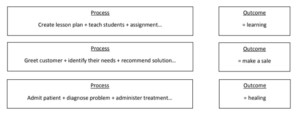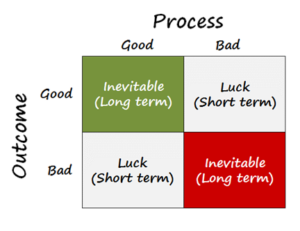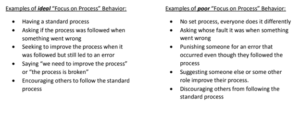POSTED APRIL 30, 2020 ADMIN
Use Good Processes to Deliver Value to Customers
As you begin learning about CI principles, there are two important things you must master. First, the purpose of everything we do is to deliver value to the customer. We should always be thinking about who the customer is and what they want. A good practitioner of CI will always be analyzing the work they do to determine how it can be improved to deliver a better experience for the customer. Every time you create standard work or improve a process the customer experience should always be the top priority.
Second, everything centers on a “process focus”. Processes turn uncertainty into stability. Processes are the means by which we deliver value to the customer. They create order from chaos. To provide good service, you must have a good process. If something goes wrong, or there is a problem for the customer, 99% of the time it is because the process is faulty and not because someone made a mistake. CI is all about creating processes and improving processes.
How do you “flow value for the customer?
The purpose of any process is to deliver value for the customer. We often refer to this as the “customer experience”. When it comes to designing a good process to achieve a good outcome, the best way to achieve this is to design a process that will deliver the best value to the customer without interruptions. This is called flow. The better the process flows, the more value it can deliver and the happier the customer will be. Think about ordering a meal at your favorite fast food chain. Most likely they have developed a smooth flowing process to take your order and get you your food quickly with good quality. Otherwise, you probably wouldn’t like to eat there. Now think about a time when you had terrible service somewhere and ended up waiting a long time for something. That’s an example of poor flow. Which of the pictures below best represents your process?

In order to create good flow you must be constantly examining your processes to find ways to improve the flow. What barriers are getting in the way and impeding the flow of value added services to the customer? Can you remove any of those barriers to improve the flow? This is one of the most fundamental principles of CI. As you continue to learn more about CI, you will learn many techniques designed to help you analyze and improve the flow of your processes.
How do you “focus on process”?
Every service we provide and every product we create is the output of processes designed to create value for a customer. A good process will result in a good output, or good products and services. A bad process will result in a bad output, or bad products and services. Everything we do can essentially be described with a simple math equation:

Simply put, the steps of the process are what creates the outcome. You can change the outcome by changing the steps of the process. If an outcome is different than you expected, it is likely that something changed in the process. Here are some examples:

All too often in our organizations, we focus only on the outcome and spend little to no time considering the process that led to that outcome. An example of this would be setting a sales target, and then not really having a well-defined way to achieve it. Another example, would be getting angry with an employee because of a mistake on an invoice and not considering that a poor process may have led to the error rather than a person. The first step to focusing on process is to start asking the question: What is the process? If your goal is to lose weight, then ask yourself what is the process you will use to lose weight? If the outcome you desire is a good grade in your college finance class, what process will lead you to good grades? If your goal is a good phone call with a potential client, what process steps will you follow to achieve a good phone call? Think about your work and the results you are trying to achieve. Then ask yourself what is the process? If there is no process, you must create one.
Next you must consider that just because you have a process, doesn’t mean it is the right process. It is thus important to ask: Will the process lead to a consistently good outcome? The diagram below illustrates the importance of having the right process in place.

A well thought out, good process will result in a deliberate, good outcome. When the right process is in place, a bad outcome will be infrequent and rare. A poorly designed, bad process will have the opposite effect and result in bad outcomes. Any good outcomes from a bad process are most likely short term and will not be consistent. You should always be thinking about what process steps you can put in place or change to ensure a more consistent and positive outcome.
The last way to focus on process, has to do with how you handle problems when they arise. When something goes wrong, ask: Was the process followed? If it wasn’t followed, then you know the cause of the problem and can fix it by following the process. If the process was followed, and the problem still occurred, ask: Does the process need to be improved? If possible, make enhancements to the process that will prevent that problem from occurring in the future.

